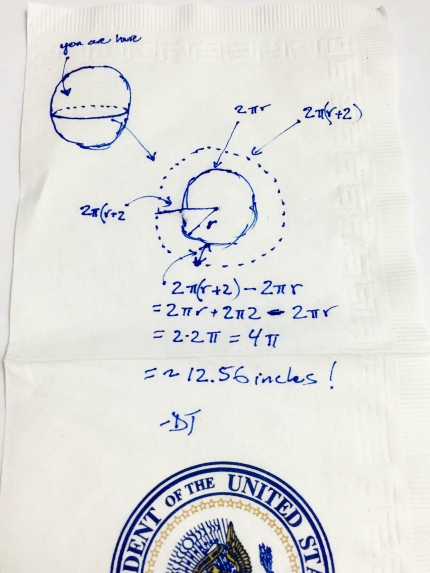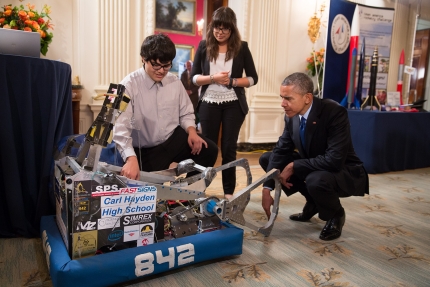Office of Science and Technology Policy Blog
Advancing Understanding of Particle Beam Therapies for Cancer Treatment
Posted by on April 3, 2015 at 3:46 PM EDTThe National Cancer Institute (NCI) and the Department of Energy (DOE) recently issued awards to plan for future research capabilities and to advance instrumentation and methods for particle beam therapies that could potentially complement or provide alternatives to certain cancer therapies.
In another step to stay on the cutting edge of this promising field, the NCI this week announced an upcoming solicitation for proposals to conduct clinical trials on “Carbon Ion versus Conventional Radiation Therapy for Locally Advanced, Unresectable Pancreatic Cancer.”
This type of cancer is particularly difficult to treat; only about 10% of patients diagnosed with inoperable pancreatic cancer survive for more than two years, and their prognosis has not improved much since the 1970s.
Carbon ion beam therapy is not yet widely available but researchers have reported that, in studies, nearly half of pancreatic cancer patients who were treated with carbon ion therapy survived to the two-year mark or beyond.
Appropriately controlled trials such as those sought by NCI are needed to validate the benefits of such therapies.
In preparation for the solicitation, NCI issued a Sources Sought Notice late last year with information about protocols and processes that were being considered. The announcement of the solicitation appeared this week in Federal Business Opportunities and the full solicitation will be published via the same vehicle in the near future.
The initiation of clinical trials is a critical next step in quantifying the efficacy of carbon ion therapy, and in building a solid foundation of evidence upon which to move forward in this promising area.
Altaf H. (Tof) Carim is Assistant Director for Research Infrastructure, White House Office of Science and Technology Policy
Learn more about TechnologyCitizen Science is Everywhere, including the White House
Posted by on March 25, 2015 at 12:04 PM EDTMillions of volunteers across our Nation actively contribute valuable time and expertise to help advance our understanding of the world around us. Through citizen science, members of the public can participate in the scientific process, including identifying research questions, making new discoveries, collecting and analyzing data, interpreting results, developing technologies and applications, and solving complex problems. Equipped with interactive web tools and readily-available tools like cell phone cameras and water-quality test kits, citizen scientists collect data and act on the results to accomplish fascinating and important work: from determining the structure of an AIDS-related enzyme to support development of new medications, to mapping the 3D structure of neurons in the brain. Through citizen science, the public also has discovered a new class of galaxy (the rare “green pea” galaxies), and helped to map the surface of Mars.
This week, the White House hosted the 5th annual White House Science Fair. One of the student exhibitors demonstrated the impact citizen science can have on both learning and research outcomes. High school senior Tiye Garrett-Mills Tiye investigated more economically viable and efficient ways to create images of the vein systems in leaves.
Learn more about Education, TechnologyEmpowering the Next Generation of Engineers to Address the Grand Challenges of the 21st Century
Posted by on March 24, 2015 at 9:29 AM EDTAt the 2015 White House Science Fair yesterday, President Obama hosted outstanding young scholars from across the country to celebrate their achievements in science, technology, engineering, and math (STEM). One of the scholars he met was Michaela Rikard, a biomedical engineering student at North Carolina State University.
Michaela is one of a growing number of undergraduates participating in Grand Challenge Scholars Programs at colleges and universities nationwide. These programs empower students to tackle some of the most important challenges of the 21st century, such as making solar energy cost-competitive with coal and providing clean water for the nearly 1 billion people who lack access. As a Grand Challenge Scfholar, Michaela wants to develop new medical therapies that are personalized, affordable, and readily available worldwide. She’s conducted research to improve the use of nanotechnology to detect and treat cancer, and has worked with the military to help soldiers with amputations that are suffering from complications.
Thanks to a new initiative launched by over 120 Deans of Engineering at campuses nationwide, over the next decade at least 20,000 undergraduate students will have the opportunity to tackle Grand Challenges: ambitious but achievable goals that will require advances in science and technology to achieve. Students will combine interdisciplinary coursework, research, hands-on design projects, service learning, a semester abroad, and an entrepreneurial experience to ensure that they have the skills and the mindset needed to meet Grand Challenges.
Learn more about Education, TechnologyThe Incredible Kid-Ingenuity on Display at the Fifth White House Science Fair
Posted by on March 23, 2015 at 5:51 PM EDTToday, the halls of the White House were packed with science projects -- robots, 3D-printed objects, computer programs, apps, and extraordinary scientific discoveries -- all built, invented, designed, and brought to fruition by students.
At the fifth-annual White House Science Fair, President Obama welcomed more than 100 students from more than 30 states for a celebration and showcase of their truly remarkable achievements in science, technology, engineering, and math (STEM).
As part of the Science Fair, approximately 35 student teams exhibited innovative projects -- including discoveries and insights in key areas such as disease diagnostics, clean energy, and information security -- as well as inventions ranging from the “why didn’t I think of that?” (automatic page-turner for people with arthritis) to the “who’d have ever thought that possible?” (a hiccup-curing lollipop!).
The President personally viewed some of these projects, marveling at the incredible ingenuity on display from student innovators across the country including some as young as six years old.
Learn more about Education, TechnologyCelebrating Sunshine Week 2015
Posted by on March 20, 2015 at 6:25 PM EDT We conclude the 10th Sunshine Week celebrations with an update on the Open Government Initiative started six years ago by President Obama. As part of the Initiative, U.S. agencies are increasingly adopting a “default to open” approach, making more information, data, and records available online than ever before. This week, the Federal government also launched the first government-wide public analytics web dashboard, which is hosted by the General Services Administration (GSA) at analytics.usa.gov.Learn more about
We conclude the 10th Sunshine Week celebrations with an update on the Open Government Initiative started six years ago by President Obama. As part of the Initiative, U.S. agencies are increasingly adopting a “default to open” approach, making more information, data, and records available online than ever before. This week, the Federal government also launched the first government-wide public analytics web dashboard, which is hosted by the General Services Administration (GSA) at analytics.usa.gov.Learn more aboutBack-of-the-Napkin Math, with DJ Patil: #PiDay Challenge
Posted by on March 16, 2015 at 10:25 AM EDTI hope you had an epic pi(e) day. For me, it was an opportunity to indulge in all the various forms of pi and pie (including a deconstructed apple pie). I wanted to follow up and share the answer to our pi day math brain teaser. Just a reminder, here’s the problem again:
On March 16, 2015, U.S. Chief Data Scientist DJ Patil scribbled out a "back-of-the-napkin" solution to a math problem he challenged the public to solve in honor of Pi Day 2015.
“Imagine you have a rope snug all the way around the equator. Now you need to add some rope so that the rope is 2 inches above the ground all the way around. How much rope do you need to add?”
The really cool thing about this problem is that it goes counter to our intuition. We think of the Earth’s equator as huge and therefore the amount of rope needed to be added must be large. But let’s do the math.
The equator of the Earth is a circle and the circumference is 2 x pi x r (or 2πr).
The radius with the height 2 inches off the ground would be r+2 inches, and the circumference would then be 2 x pi x (r+2) (or 2π(r+2)).
Let’s subtract these to get how much rope we would need and we get 2 x pi x r - 2 x pi x (r+2).
Doing some quick math, you get 2 x pi x (r+2) - 2 x pi x r = 2 x pi x r – 2 x 2 x pi - 2 x pi x r = 4 x pi. There you have it.
All you would have to add is 4 x pi inches or approximately 12.56 inches of rope! Crazy, but true.
That’s why you need math!
DJ Patil is U.S. Chief Data Scientist
Learn more about Education
- &lsaquo previous
- …
- 10
- 11
- 12
- 13
- 14
- 15
- 16
- 17
- 18
- …
- next &rsaquo
White House Blogs
- The White House Blog
- Middle Class Task Force
- Council of Economic Advisers
- Council on Environmental Quality
- Council on Women and Girls
- Office of Intergovernmental Affairs
- Office of Management and Budget
- Office of Public Engagement
- Office of Science & Tech Policy
- Office of Urban Affairs
- Open Government
- Faith and Neighborhood Partnerships
- Social Innovation and Civic Participation
- US Trade Representative
- Office National Drug Control Policy
categories
- AIDS Policy
- Alaska
- Blueprint for an America Built to Last
- Budget
- Civil Rights
- Defense
- Disabilities
- Economy
- Education
- Energy and Environment
- Equal Pay
- Ethics
- Faith Based
- Fiscal Responsibility
- Foreign Policy
- Grab Bag
- Health Care
- Homeland Security
- Immigration
- Innovation Fellows
- Inside the White House
- Middle Class Security
- Open Government
- Poverty
- Rural
- Seniors and Social Security
- Service
- Social Innovation
- State of the Union
- Taxes
- Technology
- Urban Policy
- Veterans
- Violence Prevention
- White House Internships
- Women
- Working Families
- Additional Issues



